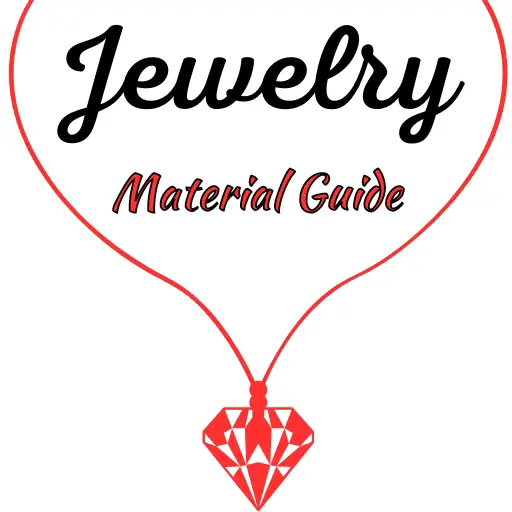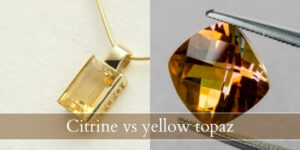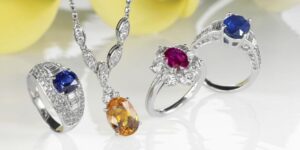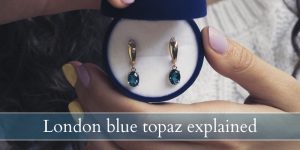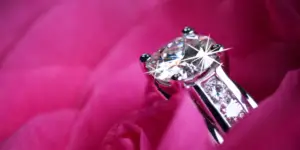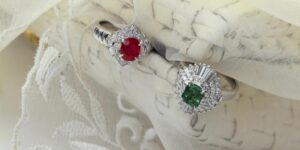Diamonds are very well known for their ability to sparkle more than any other gemstone, and they are often used as an example of perfection. And when most people think of a diamond, they think of the clear ones, brilliant and fiery. And now you’ve probably heard of black diamonds, or seen a photo of something claiming to be a black diamond and you now want to know if that’s even a real thing.
So are black diamonds real ? Are they just a scam and you’re just getting sold some onyx ? If black diamonds are real, how expensive are they ? Are they rare ? Let’s explore this topic for a bit, because in the past decade alternatives to diamond rings have become quite popular, including non-traditional diamonds, and here is where the black diamond comes in. Let’s take a look.
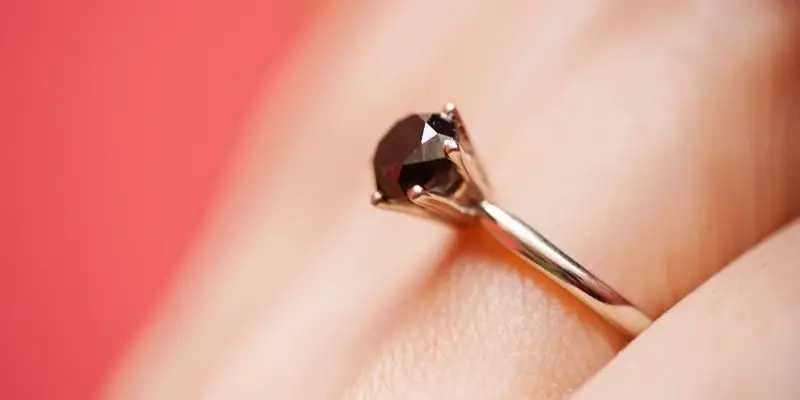
Are black diamonds real ?
Black diamonds are real, and they are indeed diamonds, as in the solid form of the element carbon. The difference between black diamonds and other diamonds is that the carbon has turned into graphite within the crystal lattice. This is due to immense pressure and heat over a very long period of time. The graphite inclusions within the diamond have extended so far that the diamond now looks opaque, so it looks fully black and no light may enter it.
Black diamonds are essentially very, very, very old diamonds, because they’ve started to break down into graphite here and there. Nevertheless these diamonds are real diamonds, with the same Mohs rating of 10 and still quite pretty.
Are black diamonds rare ?
Yes, black diamonds are quite rare. As black diamonds are essentially just ancient diamonds, there aren’t that many to go around, at least not very many that are fully black and opaque. This makes black diamonds a rare find, much like a perfectly clear diamond is a rare find. But, the demand for black diamonds isn’t as high as it is for the clear, sparkly ones.
So black diamonds are also rare on the market, because there isn’t much of a demand for them. You can find them at some jewelers, but you will need a lot of patience.
Most black diamonds on the market today are HPHT treated
The black diamonds you can find are mostly treated, in order to get them to that opaque level. Most commercial black diamonds start out as heavily included brown diamonds, and undergo a high pressure, high temperature (HPHT) treatment to accelerate the growth of the graphite inclusions.
Does this make them any less impressive than a natural black diamond ? We don’t think so, in the end the base is still a natural diamond. But this is something you should be aware of, especially when someone tries to pass off a black diamond as 100% natural.
Are black diamonds stable ?
Black diamonds owe their color and opacity to high amounts of graphite inclusions, which essentially weaken the diamond structure. But in the short term, black diamonds are stable in that they will not break down within your lifetime. But they are a bit more fragile than other diamonds, especially if the graphite inclusions have reached the surface as tiny little cracks or grooves.
Of course, most black diamonds will survive a fall and won’t chip immediately, but they might very easily if cut into very sharp shapes like a marquise, pear, or princess cut.
Read also: Radiant VS Oval Diamond
Do black diamonds sparkle ?
No, black diamonds cannot sparkle because light cannot enter a black diamond. The level of opacity on a black diamond is nearly 100% so even if a bit of light were to get in, it would hit immense amounts of graphite and not return to the surface.
So if you’re looking for a black diamond that also sparkles, you’re not looking for an actual black diamond. You have a better shot with a heavily included salt and pepper diamond that still allows some light to enter, or a dark grey moissanite.
How do you know it’s a black diamond and not another gem ?
A key feature of a black diamond is its adamantine luster, and the inclusions reaching the surface. The luster is also present in clear diamonds, but not noticeable as it has nothing to contrast it, like a color. Once the diamond becomes a bit opaque due to inclusions, the luster is obvious. It looks like a sheen on the very surface of the diamond, like a perfect mirror but with a bit of a metallic hint to it.
As for the inclusions, often a few of them reach the surface, so it looks like the black diamond has very tiny pock marks. Pair this with the adamantine luster and you get a very specific look that isn’t present in other gemstones.
Even if you compare it to onyx or black agate, the luster is not the same, and any surface scratches will look very different to a diamond’s inclusions.
Are black diamonds expensive ?
Black diamonds are quite affordable, especially given their lack of sparkle. A 1ct black diamond goes for an average of $2,500 per carat, which is far, far less than a 1ct clear diamond, even for an I clarity one.
So if you’re looking to get a diamond that is very different than most, a black diamond is a great option. Just have realistic expectations. It will not sparkle, and it will not dazzle. It will however impress through its contradicting nature – how can a diamond, known for being fiery and brilliant, be completely opaque ? Definitely a conversation piece.
Black diamond alternatives
If you’re looking for alternatives for your black diamond there are a couple directions you can go, depending on what you’re looking for in your diamond. Some of these are completely opaque, some let some light enter. Take a look.
Smoky or rutilated quartz
Smoky and rutilated quartz look quite different from one another but they offer you the same thing, a semi-transparent looking black diamond alternative. Smoky quartz has a bit of a brown hue but it can also come in dark grey/black. Think of it like looking through a piece of black organza.
Rutilated quartz is usually coppery-gold but it can also be found with black inclusions. This type of quartz is completely clear with varying amounts of rutile inclusions that look like threads or very thin needles. There are a few rutilated quartz stones that have both black rutile and are heavily included, leading to a very similar look to a black diamond with occasional tiny clear pockets.
Onyx or black agate
Both onyx and black agate will offer that opaque, inky black look that some people love about a black diamond. What they don’t offer though is the mirror-like luster of a black diamond, so be prepared. They are amazingly affordable and can be easily sourced in any shape you like, so there’s also that.
Heavily included salt and pepper diamonds
Salt and pepper diamonds are, essentially, halfway black diamonds. They are clear diamonds that have formed different tiny inclusions, sometimes white, sometimes, grey, sometimes black, or a combination of all three. Most of the time these diamonds are cloudy-looking, but you can still find ones that have a clear body with a very high amount of graphite inclusions.
The effect, when the diamond is cut into a brilliant shape, is a dark grey/black looking diamond with a bit of sparkle. You can’t pass this off as a black diamond, but it makes for a nice alternative. Salt and pepper diamonds are about as affordable as black diamonds.

I’m the main author for jewelrymaterialguide.com. I started this site after we did tons of research before our wedding and noticed that there is information about rings, jewelry, and so on that is really hard to find on the internet.
